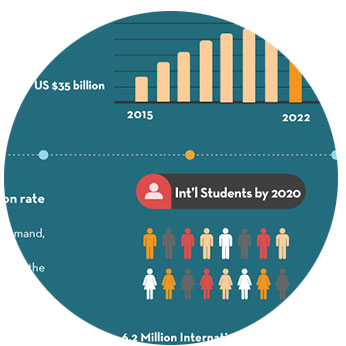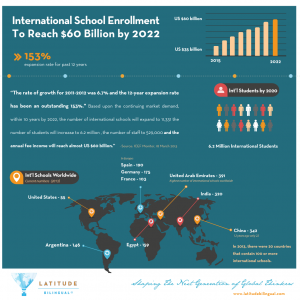
 The enrolment market for International schools is near to attaining 60 billion dollars between now and 2022
The enrolment market for International schools is near to attaining 60 billion dollars between now and 2022
With the expansion of the international schools market, ICEF Monitor, in their March 2013 edition, reviewed some revealing statistics as well as the factors behind this latest trend.
Nicholas Brummit, founder and director general of the Conseil des Ecoles Internationales (ISC_International School Consultancy) Research Ltd, presents findings which estimate the total number of English speaking international schools at 6 533.
Not only are new schools constantly opening, but their numbers are growing each time existing schools convert to an international programme, begin delivering lessons in a foreign language ( usually English), or open a satellite campus in another country. The rate of growth for the period 2011-2012 was 6.7%, and the rate of expansion over twelve years has reached the amazing figure of 153%.
This huge growth goes against current economic trends, but seems to follow. At the last Ecoles Internationales et de l’Enseignement Privé forum, Brummit states :
” « Based on the continued market demand, in the next 10 years (now until 2022), the number of international schools will reach 11 331, the number of students will grow to 6.2 million, the number of employees 529 000, and the yearly turnover will approach 60 billion dollars. »
As much as teaching in English dominates international schools, it is interesting to note that other countries are also present in the market. France is such an example. Teaching completely in French is offered in some schools in China, Tunisia and Vietnam. There are also French international schools which offer bilingual teaching in French and English in the UK and in America.
Population Growth as a Contributor
International schools first appeared as education for mobile international families. Whilst until very recently, in the last thirty years, these schools had a mainly expatriate pupil population, the tendency has completely inverted. Today, local residents account for about 80% of places in international schools and make up about two thirds of the market expansion.
In a November interview with Re :locate Magazine, Brummit cites both local and expatriate influence for this increase :
« The next ten years will see , no doubt, a huge growth in the international school market, a demand resulting from the growth of the expatriate market and the growing number of wealthy local families who recognise the value of teaching in English for their children. »
| Other Factors for Growth
If this demographical factor is key, it is closely linked to profitable aspect of the market: the value of the entire international school market is thought to be just over 30 billion dollars. As Brummit indicates below, if the current trend is confirmed, the annual turnover could reach 37 billion US dollars between now and 2015, and 60 billion between now and 2022. Similarly, a third driving factor for the international school market growth is the role they play in the host country’s economy. As international Primary or secondary school is often seen by families in developing countries as a stepping stone for foreign universities, governments promote international education as a way to stem a country’s ’brain drain’, allowing them to hold onto their top students. Fees are on the up and places are in decline L’ISC Research underlines the fact that international schools respond to the 5% most wealthy non Anglophone people. That will remain so for a certain period of time, as the fees have gone up everywhere due to insufficient numbers of international primary and secondary schools. The economic crisis has hit locals and expats. Waiting lists are the order of the day everywhere, and according to the Telegraph, the lack of school places has led to some expatriate families leaving Hong Kong. According to a more recent article, the problem is so bad that some expatriate families will not accept a job placement without the guarantee of a school place for their child first. Quality is feeding the growing trend Lastly, Brummit draws our attention to « the growing trend of sending children to local international schools rests on the quality of teaching and learning which many schools offer, linked to the recognised value placed by local families on teaching in English. »
|
Therefore, the international bilingual market, of which Latitude Bilingual ® is a part, responds to a growing expectation of parents looking for excellent local teaching combined with a mastery of the English for their child. Current difficulties of everyday life and those foreseen in the future ( high levels of unemployment, especially for young people is a preoccupation for parents) need solutions for children’s schooling to be found in order to prepare them for the world of tomorrow. Despite the economic crisis, parents are always willing to put money into their children’s schooling and quality activities. This concern is evident in parents’ worry and desire for their children to succeed and do well.
